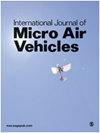Unmanned aerial vehicle control costs mirror bird behaviour when soaring close to buildings
IF 1.6
4区 工程技术
Q2 ENGINEERING, AEROSPACE
引用次数: 3
Abstract
Small unmanned aerial vehicles (SUAVs) are suitable for many low-altitude operations in urban environments due to their manoeuvrability; however, their flight performance is limited by their on-board energy storage and their ability to cope with high levels of turbulence. Birds exploit the atmospheric boundary layer in urban environments, reducing their energetic flight costs by using orographic lift generated by buildings. This behaviour could be mimicked by fixed-wing SUAVs to overcome their energy limitations if flight control can be maintained in the increased turbulence present in these conditions. Here, the control effort required and energetic benefits for a SUAV flying parallel to buildings whilst using orographic lift was investigated. A flight dynamics and control model was developed for a powered SUAV and used to simulate flight control performance in different turbulent wind conditions. It was found that the control effort required decreased with increasing altitude and that the mean throttle required increased with greater radial distance to the buildings. However, the simulations showed that flying close to the buildings in strong wind speeds increased the risk of collision. Overall, the results suggested that a strategy of flying directly over the front corner of the buildings appears to minimise the control effort required for a given level of orographic lift, a strategy that mirrors the behaviour of gulls in high wind speeds.无人驾驶飞行器的控制成本反映了鸟类在接近建筑物时的行为
小型无人机由于其机动性,适合在城市环境中进行许多低空作业;然而,它们的飞行性能受到机载能量存储和应对高水平湍流的能力的限制。鸟类利用城市环境中的大气边界层,通过利用建筑物产生的地形升力来降低其高能飞行成本。如果能够在这些条件下增加的湍流中保持飞行控制,则固定翼SUAV可以模拟这种行为,以克服其能量限制。在这里,研究了在使用地形升力的同时,SUAV与建筑物平行飞行所需的控制力和能量效益。建立了动力SUAV的飞行动力学和控制模型,用于模拟不同湍流风条件下的飞行控制性能。研究发现,所需的控制力随着海拔高度的增加而减少,所需平均节气门随着与建筑物的径向距离的增加而增加。然而,模拟显示,在强风中靠近建筑物飞行会增加碰撞的风险。总体而言,研究结果表明,直接飞越建筑物前角的策略似乎可以最大限度地减少给定地形升力水平所需的控制力,这种策略反映了海鸥在高风速下的行为。
本文章由计算机程序翻译,如有差异,请以英文原文为准。
求助全文
约1分钟内获得全文
求助全文
来源期刊

International Journal of Micro Air Vehicles
ENGINEERING, AEROSPACE-
CiteScore
3.00
自引率
7.10%
发文量
13
审稿时长
>12 weeks
期刊介绍:
The role of the International Journal of Micro Air Vehicles is to provide the scientific and engineering community with a peer-reviewed open access journal dedicated to publishing high-quality technical articles summarizing both fundamental and applied research in the area of micro air vehicles.
 求助内容:
求助内容: 应助结果提醒方式:
应助结果提醒方式:


